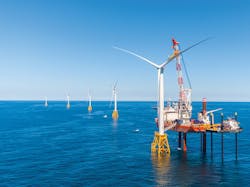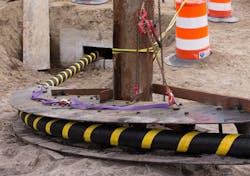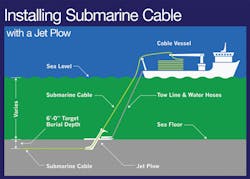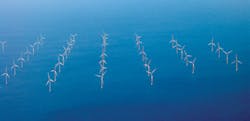America’s First Offshore Wind Farm Is Operational
The nation’s newest wind farm isn’t harnessing energy on a mountain ridge or an open field. Instead, its turbines’ blades are spinning over the Atlantic Ocean — just 16 miles off the coast of mainland Rhode Island.
Fully operational in December, the Block Island Wind Farm is the nation’s first commercial offshore wind farm with five turbines that generate a total capacity of 30MW. The output from the wind farm connects to Block Island, a tourist destination formerly dependent on diesel generators. From Block Island, a new underwater power cable named “sea2shore” connects the island to the mainland electrical grid.
The new offshore wind farm will not only meet 90% of the island’s annual electricity demand and pump electricity directly into the New England grid, but it has also jump-started a new energy industry in the United States, according to Deepwater Wind, the developer of the Block Island Wind Farm. For example, the offshore wind industry is creating new opportunities for electrical contracting firms both on land and at sea. As part of an offshore wind farm project, electricians must wire substations, provide power to work sites, connect cabling, and install electrical systems within wind turbines.
“There’s a lot of conventional electrical construction that comes out of an offshore wind project, but there are also highly specialized areas as well,” says David Campilii, project engineer for National Grid, a distribution company responsible for the installation and interconnection of the submarine cable to the power grid. “Both were critical to connecting the mainland power grid to the island and the offshore wind farm.”
Jeff Audet, project manager for E.W. Audet & Sons, Inc., a commercial electrical contracting firm based in Providence, R.I., says Block Island was the first offshore wind farm his company had worked on, and he is also planning on bidding on a future project in Long Island, N.Y.
“It was very exciting, and I am proud that our company was able to perform the work,” Audet says.
While the Block Island Wind Farm has five turbines — compared to as many as 300 on European offshore wind farms — the “small, yet mighty” project is just the beginning, according to E.W. Audet & Sons. In the future, the contractor forecasts the Block Island project may pave the way for even more electrical contracting services associated with offshore wind farms.
Embracing opportunities and overcoming challenge
The Block Island Wind Farm is part of the trend to boost renewable energy production, according to the American Wind Energy Association (AWEA), a national trade association of the U.S. wind energy industry. In fact, the AWEA estimates that the overall offshore wind resource potential in the United States is four times the generating capacity of the entire U.S. electricity grid.
As an abundant, low-carbon, domestic energy source, offshore wind can produce energy at low, long-term fixed costs, and the wind generally blows harder and more uniformly over the sea than on land, according to the U.S. Department of the Interior’s (DOI’s) Bureau of Ocean Management (BOEM).
With coastal cities having the highest average electricity rates, offshore wind farms are often located near these cities, which account for almost 80% of the U.S. electricity demand and 53% of the nation’s population. Situating the wind farms close to these major coastal load centers can help developers reduce the cost of electricity during peak times. In addition, they provide an alternative to constructing long-distance transmission lines or developing electricity generation in land-constrained regions.
As states decommission coal power plants, many are seeking ways to meet renewable energy targets, according to the U.S. Department of Energy’s (DOE’s) Wind Energy Technologies Office and the BOEM. But for many of the coastal cities, land-based renewable energy resources may be limited.
U.S. waters, however, have a technical potential of 2,058GW of offshore wind resource capacity, according to the DOE and DOI. The resulting energy output of 7,200 terawatt-hours per year could provide nearly double the total electric generation of the United States. But like any emerging market, the offshore wind sector not only presents opportunities, but also challenges. For example, the cost of offshore wind energy is currently too high to compete in most U.S. markets without subsidies, according to the DOE and DOI report titled, “National Offshore Wind Strategy: Facilitating the Development of the Offshore Wind Industry in the United States.”
The Block Island Wind Farm cost $451 million, which included $225 million for equipment, construction and installation; $118 million for design, legal and permitting; and $108 million for the undersea cable connecting the wind farm to the mainland Rhode Island grid. Furthermore, the wind farm will supply only 1% of Rhode Island’s energy needs, and the price of power will be higher than what most utilities pay for electricity generated by burning fossil fuels.
To drive down capital costs and operating expenses and increase energy production, the U.S. offshore wind energy industry could increase turbine size and efficiency or reduce the mass of substructures. In addition, as more projects are underway, and the supply chain for offshore wind development builds up, costs could also come down over time.
E.W. Audet & Sons says one reason why this project was so costly stems from the fact that the turbines were primarily built overseas and then installed using a multi-million-dollar ship from Norway.
According to the AWEA, to develop wind at scale, several things must happen:
• The industry must employ thousands of U.S. workers to manufacture, construct, and service offshore wind farms.
• American factories need to fabricate the turbine components close to where they are needed.
• States must upgrade their ports and electric transmission infrastructure.
Installing undersea infrastructure
While the domestic offshore wind industry still has challenges to overcome, the 6MW turbines are already spinning and producing power at wind speeds from 6.5 to 56 mph on the Block Island Wind Farm. This site, however, didn’t rise out of the ocean overnight. The entire process — including commercial negotiations, design, permitting, construction, and ultimate operation — spanned more than seven years, Campilii says.
Rhode Island offered many key advantages as the site of the first offshore wind farm with its shallow waters, connection to the mainland, and reasonable wind speeds and location, Campilii says. To go from the idea stage to a reality, however, the project needed full political support. As such, the state passed legislation back in 2009 supporting offshore power generation, which provided a catalyst for the development of the project. In turn, National Grid agreed to purchase 100% of the output of the wind farm.
Just as electric utilities often construct new power lines to transport renewable energy from utility-scale wind and solar farms, offshore wind farms also require installation of new infrastructure. Instead of setting poles and stringing wire on land, however, the technicians buried a specialized submarine cable under the sea floor. National Grid and its contractors installed 20 miles of 3-phase power cable from Block Island to the mainland. Deepwater Wind, using the same contractors, installed about 8.5 miles of 3-phase submarine cable from the wind farm to Block Island.
“Before the wind farm project, Block Island had no power connection to the mainland,” Campilii says. “None of the submarine power cable existed prior to the project. We installed the cable link between the mainland and Block Island in support of the offshore wind development and to provide a source of power to Block Island.”
To install the undersea cable, National Grid contracted with a South Korean cable manufacturer to produce a single piece of 3-phase power cable weighing 5 million pounds. After testing the cable, the manufacturer then loaded it on an ocean vessel to transport it from South Korea to Rhode Island. Once the cable arrived state-side, it was transported on a barge specially modified to serve as a cable-laying vessel. The workers then installed four miles of underground cable on the mainland and three-quarters of a mile of land cable on the island. Workers used a horizontal drill to bore through more than 1,500 ft of offshore bedrock and pulled the submarine cable through the conduit and into an onshore manhole.
To bury the submarine cable into the sea floor from mainland Rhode Island, National Grid and its contractors used a jet plow, a specialized machine that rides on the sea floor with skis. The cable is unwound from the lay vessel and then directed down to the plow, which has a hollow blade. As the cable is fed through the leading edge of the blade, a water nozzle pumps 5,000 gallons of water per minute down to the plow. This temporarily liquefies the soil, the plow buries the cable, and the liquefied soil closes up behind the plow as it is dragged forward (see Figure).
Inside the submarine cable are three insulated 34.5kV power conductors, which make up the 3-phase power circuit. In addition, a fiber optic cable is built into the inside of the cable, and the exterior of the cable is covered with steel armor for added mechanical protection.
The cable is buried at a minimum depth of 4 ft and a maximum depth of 6 ft. At this depth, the cable can be kept out of most anchor strikes and recreation and commercial fishing issues. In some spots, where it could not be buried at this preferred depth, workers installed concrete pads on the top of the cable for added protection. This approach, however, wasn’t always feasible. For example, 200 ft off shore from Fred Benson Town Beach, workers installed an 80-ft section of cable 3 ft deep rather than the preferred 6 ft below the seabed due to rock formations. A month after the wind turbines started spinning, a cable survey indicated that the cable was not buried at the proper depth, according to the Block Island Times. As such, National Grid plans to work on a solution with appropriate agencies to rectify this situation.
Performing electrical work
In addition to installing the submarine cable, the construction team also worked on many other projects to get the offshore wind farm up and running. For example, electrical contractors installed the low-voltage communication and protection wiring for two new substations. In addition, an underground cable installer pulled 35kV distribution cable on to the mainland and then performed the conventional splicing in a newly constructed duct line and manhole system.
The electrical contractors also handled the pre-assembly of the wind turbine units on land. Aladdin Electric, the service contractor for the Port of Providence, worked with Local 99 to construct a pre-assembly facility — a 200-ft by 120-ft canvas tent measuring 50 ft high. This shelter helped to protect the sensitive mechanical and electrical components from moisture and contamination during the assembly process.
“It was a staging area for the actual installation at sea, and we were responsible for everything from excavation to concrete work to providing power and heat where and when it was needed,” says Jack McGee, project manager for Aladdin Electric. “I came out of retirement to work on this project, and it was an interesting challenge.”
The developers of the wind farm leased Pier 6, where all three of the sections for the turbine tower came in from overseas. Each of the towers (which were hollow when they arrived at port) had three sections — T1, T2, and T3 — measuring about 20 ft in diameter and 196 ft long. Because the tower had to be constructed standing up rather than laying on the ground, electricians built a concrete pier so they could work on all five towers during wiring and assembly.
“Everything was constructed vertically,” McGee says. “Because the elevators couldn’t be used, the electricians had to climb the ladder to work in each position.”
E.W. Audet & Sons, which has experience with a wide range of commercial, institutional, and industrial projects, worked with Aladdin Electric to install primary power for the site. In addition, the company erected all of the electrical and mechanical components on their platforms and then lifted them up into the towers.
At the peak of the project, E.W. Audet & Sons had 10 electricians working on the project, and about 80% of the company’s scope of work took place on land. Campilii says Deepwater Wind tried to do as much electrical work on land as possible before bringing the electricians to the offshore foundations.
Once the interior fit out of the cylinders was complete, the towers were transported one at a time on a barge to the wind farm, where they were anchored to five individual footings. The wind generators stand on four-leg steel structures that reach down to the sea floor. Campilii says the extremely large foundations were similar to those for offshore oil rigs. To access these units, which were constructed out at sea, workers had to rely on specialized crane barges.
“The wind farm has similar construction to a land-based wind farm, but with the added complexity of doing everything in the water, which makes everything more difficult,” Campilii says. “There were a lot of moving parts on this project.”
To learn how to work on the wind turbines out at sea, E.W. Audet & Son’s electricians participated in 40 hours of training on confined space, fall protection, and rescue at sea. The crews worked about six days a week, and they were transported to the offshore job site by a special ferry designed for docking at the towers.
“The trip took about an hour-and-a-half each way, and it took a limited number of workers and would not load or unload if it was too rough at sea,” Audet says. “The work days started at about 5:30 a.m., and we were back at the dock by about 6 p.m.”
Looking to the future
As the Block Island Wind Farm continues to produce energy off the coast of mainland Rhode Island, other projects are in various stages of development — from the early design and licensing stage to the point where they have power purchase agreements. By the end of 2015, the DOI awarded 11 commercial leases for offshore wind development on the Atlantic Coast. When fully operational, these projects could support 14.6GW of capacity. For example, the Long Island Power Authority (LIPA) board of trustees recently approved the 90MW South Fork Wind Farm, which will be located 30 miles southeast of Montauk, N.Y. The new wind farm, also to be developed by Deepwater Wind, will produce enough electricity to power 50,000 Long Island homes. By 2030, New York Governor Andrew Cuomo has committed to develop 2.4GW of offshore wind, which could generate enough power for 1.25 million homes.
In addition to the North Atlantic, the DOE and the DOI have designated four other offshore wind resource areas — the Great Lakes, Gulf Coast, South Atlantic, and Pacific Coast. According to AWEA, several of these projects could come online before 2030.
The DOE is also supporting three Advanced Technology Demonstration Projects including the Fishermen’s Atlantic City Windfarm in New Jersey, Lake Erie Energy Development Corporation’s Icebreaker project in Ohio, and the University of Maine’s New England Aqua Ventus I. All three of these projects were in their final design and planning phase as of August 2016 and have made significant progress toward producing power, according to a report by DOE and DOI.
While the Block Island Wind Farm offered several challenges as the nation’s first commercial offshore wind farm, National Grid was proud to power and interconnect the wind farm, Campilii says.
“It had some unique aspects to it, but overall, I am quite proud with how it came out,” Campilii says. “I look forward to seeing when offshore wind turns into a real industry.”
Fischbach is a freelance writer based in Overland Park, Kan. She can be reached at [email protected].
SIDEBAR 1: Offshore Wind Goes Global
While the offshore wind industry may be new to the United States, offshore wind turbines have been spinning for more than 15 years in Europe, where 11,000MW of offshore wind contributes to the electricity supply, according to the American Wind Energy Association (AWEA).
The world’s first offshore wind farm was installed off the coast of Denmark in 1991, according to the Bureau of Ocean Management (BOEM). Fast-forward to the first half of 2016, and European countries fully connected 114 commercial offshore wind turbines with a capacity totaling 511MW, according to WindEurope, a Belgium-based global wind energy network. In addition,13 offshore wind farms were under construction. When completed, they will have a total capacity of more than 4.2GW.
In addition to Europe, other countries are also taking a strong interest in offshore wind, including China, Japan, Taiwan, South Korea, India, Portugal and Brazil, according to the Global Wind Energy Council. Globally, 4.45GW of offshore wind energy is installed with another 4.72GW under construction and an additional 30.44GW approved, according to BOEM.
SIDEBAR 2: By the Numbers
Deepwater Wind, the developer of the nation’s first offshore wind farm, shares some fast facts on the Block Island Wind Farm.
• Offshore wind farm is located 3 miles from Block Island and 16 miles from the Rhode Island mainland.
• Distance between turbines is ½ mile.
• Water depths are 75 to 90 ft.
• Five, 6MW offshore turbines produce 125,500kWh per year.
• Turbines measure 600 ft tall from the section of the foundation rising 70 ft above the water to the tip of the blade when it is vertical. The blades measure 240 ft in length.
• The blade tip speed is 200 mph, and the rotor speed is 4 rpm to 11.5 rpm.
• Steel foundations, manufactured in Louisiana and Rhode Island, weigh more than 1,500 tons and are 145 ft to 165 ft. They secure the turbines to the ocean floor with piles penetrating 200 ft into the seabed.
• Wind turbines are connected to each other and the on-shore substations by cables buried both in the seabed offshore and under roadways onshore.
• Submarine cables measure 30 miles long, weigh 1,800 tons, are rated at 34.5kV, and have a diameter of almost 7 in.
• The wind farm will reduce emissions of 40,000 tons of carbon dioxide from the region in addition to other pollutants.
Source: Deepwater Wind




